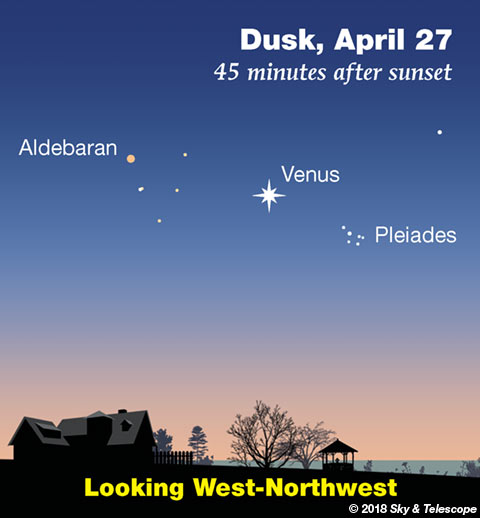
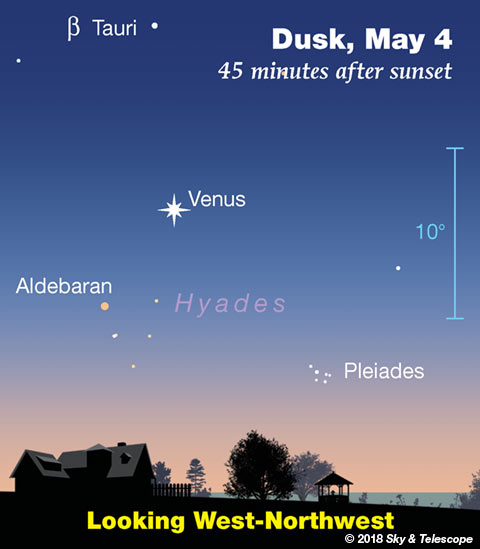
Friday, April 27
• Keep an eye on the changing pattern of Venus, Aldebaran, and the Pleiades in late twilight. Every day the stars slide a little farther to the lower right, while Venus stays at nearly the same altitude (as seen from the world's mid-northern latitudes).
• On the opposite side of the sky, look below the bright Moon for Spica. Jupiter rises far to their lower left.
Saturday, April 28
• Now Spica shines to the right of the Moon during evening. Jupiter rises in twilight, to the Moon's lower left.
Sunday, April 29
• The full Moon shines above Jupiter after dark. They may look like companions, but Jupiter is 1,700 times farther away. It's currently 27 light-minutes distant, compared to the Moon's 1.3 light-seconds.
Monday, April 30
• Now Jupiter shines to the right or upper right of the Moon after nightfall.
Tuesday, May 1
• May has sprung, but wintry Sirius still twinkles very low in the west-southwest toward the end of twilight — far to the left of much brighter Venus. How much longer into the spring can you keep Sirius in view? In other words, what will be its date of "heliacal setting" as seen by you?
Wednesday, May 2
• Arcturus is the brightest star high in the east these evenings. Spica shines about three fists at arm's length to its lower right. To the right of Spica by half that distance is the distinctive four-star constellation of Corvus, the Crow.
Far below Arcturus and Spica, Jupiter glares.
Thursday, May 3
• These spring nights, the long, dim sea serpent Hydra snakes level far across the southern sky. Find his head, a rather dim asterism about the width of your thumb at arm's length, in the southwest. (It's lower right of Regulus by about two fists at arm's length. Also, a line from Castor through Pollux points to it about 2½ fists away.) Lower left of this is Hydra's heart, orange Alphard. Hydra's tail stretches all the way to Libra in the southeast. Hydra's actual star pattern, from forehead to tail-tip, is 95° long.
• Now that the Moon is gone from the sky after dark, try for the Ghost of Jupiter planetary nebula, magnitude 7.7, in mid-Hydra (NGC 3242). At that brightness it's a potential binocular target about as easy or difficult as Neptune; it's so tiny that at low power it's easily mistaken for a star. Use Matt Wedel's Binocular Highlight article and chart in the May Sky & Telescope, page 43.
In a telescope at medium or high power, it does looks sort of like Jupiter's weak ghost dimly haunting the dark.
• Back at the real Jupiter, Europa slips into eclipse by Jupiter's shadow around 11:55 p.m. EDT. A telescope will show Europa gradually disappearing barely off Jupiter's western edge — since the planet is barely 5 days before opposition.
Jupiter's Great Red Spot crosses the planet's central meridian around 10:18 p.m. EDT. This timing is good for the Eastern and Atlantic time zones. Farther west, Jupiter is still low or hasn't risen yet.
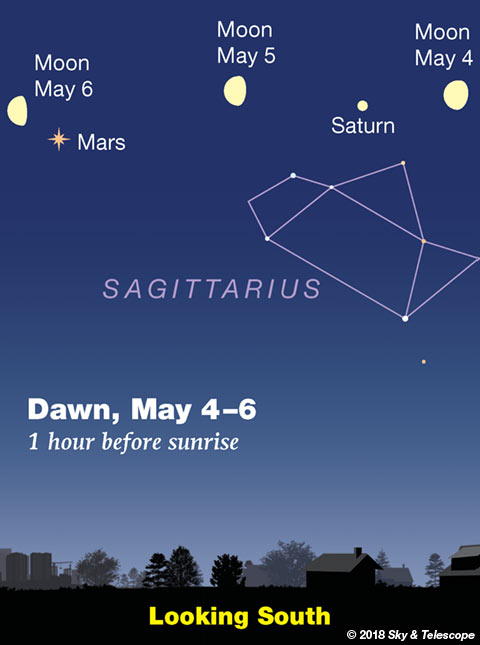
Friday, May 4
• Summer is seven weeks away, but the Summer Triangle is beginning to make its appearance in the east, one star after another. The first in view is Vega. It's already shining low in the northeast as twilight fades away.
Next up is Deneb, lower left of Vega by two or three fists at arm's length. Deneb takes about an hour to appear after Vega does, depending on your latitude.
The third is Altair, which shows up far to their lower right by midnight.
• As dawn begins on Saturday morning May 5th, the waning gibbous Moon shines between Saturn and Mars. Saturn is to the Moon's right, and Mars to the Moon's lower left.
Saturday, May 5
• Jupiter's Great Red Spot crosses the planet's central meridian around 11:56 p.m. Eastern Daylight Time.
• The Eta Aquariid meteor shower should be active before the first light of dawn Sunday morning. It's usually the best shower of the year for the Southern Hemisphere, but northerners have a poorer view of it. Moreover, the light of the waning gibbous Moon will interfere.
________________________
Want to become a better astronomer? Learn your way around the constellations! They're the key to locating everything fainter and deeper to hunt with binoculars or a telescope.
This is an outdoor nature hobby. For an easy-to-use constellation guide covering the whole evening sky, use the big monthly map in the center of each issue of Sky & Telescope, the essential guide to astronomy.

Once you get a telescope, to put it to good use you'll need a detailed, large-scale sky atlas (set of charts). The basic standard is the Pocket Sky Atlas (in either the original or Jumbo Edition), which shows stars to magnitude 7.6.
Next up is the larger and deeper Sky Atlas 2000.0, plotting stars to magnitude 8.5; nearly three times as many. The next up, once you know your way around, is the even larger Uranometria 2000.0 (stars to magnitude 9.75). And read how to use sky charts with a telescope.
You'll also want a good deep-sky guidebook, such as Sue French's Deep-Sky Wonders collection (which includes its own charts), Sky Atlas 2000.0 Companion by Strong and Sinnott, or the bigger Night Sky Observer's Guide by Kepple and Sanner.
Can a computerized telescope replace charts? Not for beginners, I don't think, and not on mounts and tripods that are less than top-quality mechanically (meaning heavy and expensive). And as Terence Dickinson and Alan Dyer say in their Backyard Astronomer's Guide, "A full appreciation of the universe cannot come without developing the skills to find things in the sky and understanding how the sky works. This knowledge comes only by spending time under the stars with star maps in hand."
This Week's Planet Roundup
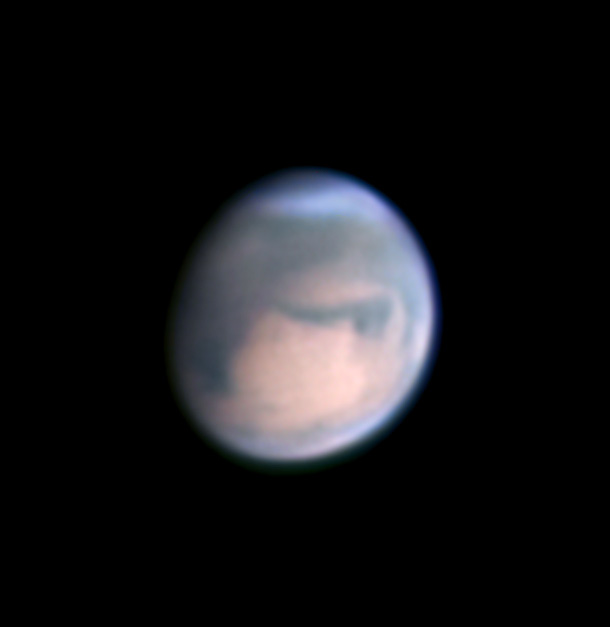
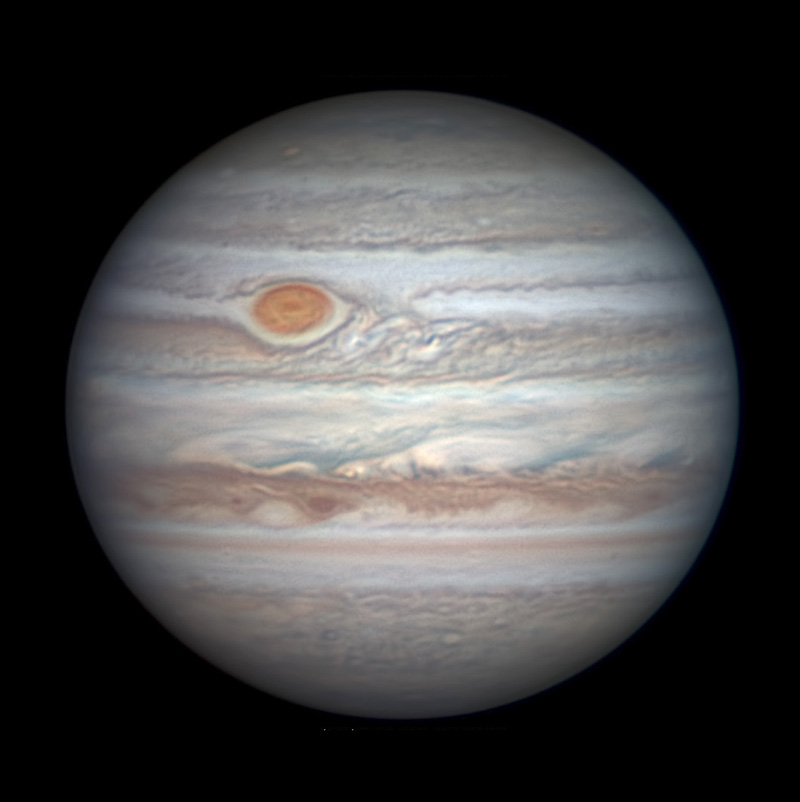
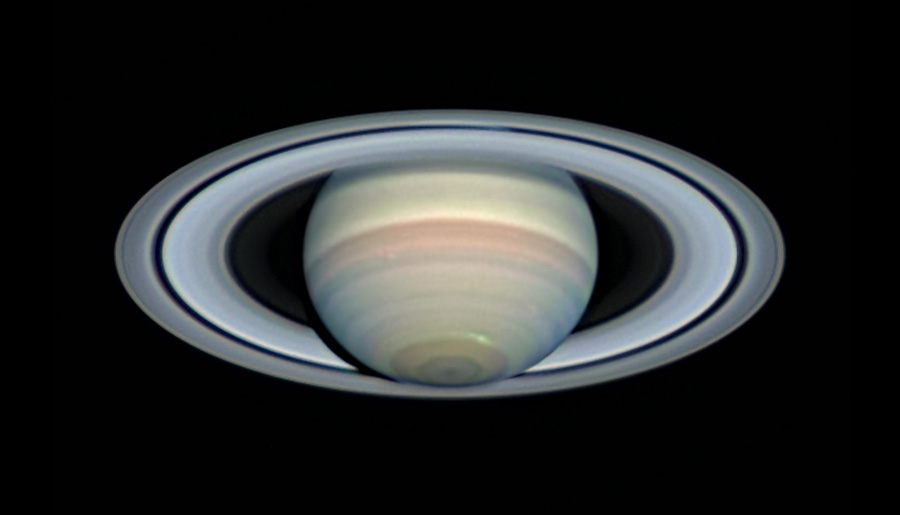
Mercury (about magnitude +0.3) is having a very low, poor apparition deep in the glow of sunrise. Using binoculars, look for it about 20 minutes before sunrise just above the horizon exactly due east.
Venus (magnitude –3.9) shines brightly in the west-northwest in twilight, nearly as high as it will get all spring and summer. It's accompanied by Aldebaran and the Pleiades, as shown at the top of this page.
In a telescope (look early!) Venus is a tiny disk 11 or 12 arcseconds wide and slightly gibbous: 88% sunlit.
Mars and Saturn rise late at night, around 1:30 a.m. and midnight, respectively (daylight-saving time). They're both in Sagittarius, shining at magnitudes –0.4 and +0.3, respectively, with Mars on the lower left. Saturn remains above the Teapot. By early dawn they're higher in the south. Their separation widens from 13° on the morning of April 28th to 17° on May 5th (when the Moon shines between them).
Mars is brightening on its way to an unusually close opposition in late July. It's already 11 arcseconds wide. What detail can you see already in your scope?
Jupiter (magnitude –2.5, in Libra) rises in the east-southeast in twilight. It shines as the brightest point in the sky after Venus sets below the opposite horizon. Jupiter is nearing its May 8th opposition, so it appears as bright and big (44½ arcseconds wide) as it will get this year. It's highest in the south, presenting the sharpest views in a telescope, around midnight or 1 a.m. daylight-saving time. By dawn it's low in the southwest.
Uranus is hidden in the glare of sunrise.
Neptune rises shortly before the beginning of dawn; wait a few more weeks.
______________________
All descriptions that relate to your horizon — including the words up, down, right, and left — are written for the world's mid-northern latitudes. Descriptions that also depend on longitude (mainly Moon positions) are for North America.
Eastern Daylight Time (EDT) is Universal Time (also called UT, UTC, GMT, or Z time) minus 4 hours.
______________________
"Remember to look up at the stars and not down at your feet. Try to make sense of what you see and wonder about what makes the universe exist. Be curious."
— Stephen Hawking, 1942–2018
______________________
"The dangers of not thinking clearly are much greater now than ever before. It's not that there's something new in our way of thinking, it's that credulous and confused thinking can be much more lethal in ways it was never before."
— Carl Sagan, 1996
______________________
"Objective reality exists. Facts are often determinable. Vaccines save lives. Carbon dioxide warms the globe. Bacteria evolve to thwart antibiotics, because evolution. Science and reason are not a liberal conspiracy. They are how we determine facts. Civilization's survival depends on our ability, and willingness, to do so."
— Alan MacRobert, your Sky at a Glance editor
______________________
"Facts are stubborn things."
— John Adams, 1770
 1
1








Comments
mary beth
April 27, 2018 at 12:17 pm
Based on your sky charts on the app for my location in Houston, Texas, the heliacal setting of Sirius will be about the second week of June. Interesting!
You must be logged in to post a comment.
You must be logged in to post a comment.